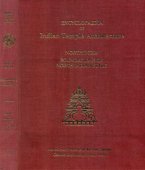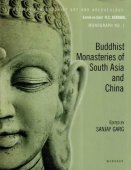Maurya: 12 definitions
Introduction:
Maurya means something in Hinduism, Sanskrit, Jainism, Prakrit, the history of ancient India. If you want to know the exact meaning, history, etymology or English translation of this term then check out the descriptions on this page. Add your comment or reference to a book if you want to contribute to this summary article.
In Hinduism
Purana and Itihasa (epic history)
Source: archive.org: Shiva Purana - English TranslationMaurya (मौर्य) refers to a group of Asuras, according to the Śivapurāṇa 2.5.16 (“The battle of the gods”).—Accordingly, as Jalandhara commanded the Asuras: “O Excellent Asuras, put up a stiff fight with Indra and other gods who are always cowardly though they have a huge army. At my bidding let all these come out with their entire army—the Mauryas numbering a hundred thousand, the Dhūmras in hundreds, the Asuras and the Kālakeyas in crores and the Kālakas, the Daurhṛdas and the Kaṅkas in lakhs. [...]”.
Source: Cologne Digital Sanskrit Dictionaries: The Purana IndexMaurya (मौर्य).—(Maurvyas, Viṣṇu-purāṇa) succeeded the Nandas. The Purāṇa speaks of ten kings ruling for 137 (173 Viṣṇu-purāṇa) years. Only nine kings are mentioned from Candragupta to Bṛhadratha; were succeeded by the Śungas.1 m.p. mentions Śatadhanva, Bṛhadratha, Śaka and his grandson Daśaratha and his son; the first four are missing.2
- 1) Bhāgavata-purāṇa XII. 1. 12 and 15; Brahmāṇḍa-purāṇa III. 74. 149; Vāyu-purāṇa 99. 336; Viṣṇu-purāṇa IV. 24. 27, 32-3.
- 2) Matsya-purāṇa 272. 22, 26.

The Purana (पुराण, purāṇas) refers to Sanskrit literature preserving ancient India’s vast cultural history, including historical legends, religious ceremonies, various arts and sciences. The eighteen mahapuranas total over 400,000 shlokas (metrical couplets) and date to at least several centuries BCE.
In Jainism
General definition (in Jainism)
Source: HereNow4u: Lord Śrī MahāvīraMaurya (मौर्य) is the father of Mauryaputra: the seventh of the eleven gaṇadharas (group-leader) of Mahāvīra.—Śramaṇa Lord Mahāvīra’s congregation had 11 gaṇadharas. All these were Brahmin householders from different places. All these gaṇadharas (for example, Mauryaputra) were Brahmins by caste and Vedic scholars. After taking initiation, they all studied the 11 Aṅgas. Hence, all of them had the knowledge of the 14 pūrvas and possessed special attainments (labdhis).

Jainism is an Indian religion of Dharma whose doctrine revolves around harmlessness (ahimsa) towards every living being. The two major branches (Digambara and Svetambara) of Jainism stimulate self-control (or, shramana, ‘self-reliance’) and spiritual development through a path of peace for the soul to progess to the ultimate goal.
India history and geography
Source: Shodhganga: The significance of the mūla-beras (history)Maurya Dynasty:—After the decline of the Indus Valley civilization, the first historical period from which sculptural evidences are available is the Mauryan Age (3rd century BC). Asoka became the supreme ruler of vast territories, and his empire extended to the limits of the Chola kingdom in the South and practically covered the whole of India. Asoka (c. 273-236 BC) encouraged and popularized the arts and utilized them to spread the message of Buddha. The Sungas (187-75 BC) and Satavahanas succeeded the Mauryas in the North and the South respectively in about 200 BC.
Source: Shodhganga: Elements of Art and Architecture in the Trtiyakhanda of the Visnudharmottarapurana (history)Maurya refers to a certain period in the history of Indian Art.—The chronological order of the development of Indian Art as stated in The Heritage of Indian Art is as follows—[...] 5. The Maurya period belongs to 325-185 B.C. This period have been adorned with early stone sculpture, Monolithic pillars, stupas and the earliest chaitya halls in the reign of Candragupta (322-298 B.C.) and Aśoka (273-232 B.C.).

The history of India traces the identification of countries, villages, towns and other regions of India, as well as mythology, zoology, royal dynasties, rulers, tribes, local festivities and traditions and regional languages. Ancient India enjoyed religious freedom and encourages the path of Dharma, a concept common to Buddhism, Hinduism, and Jainism.
Languages of India and abroad
Sanskrit dictionary
Source: DDSA: The practical Sanskrit-English dictionaryMaurya (मौर्य).—[mura-ṇya] Name of a dynasty of kings beginning with Chandragupta; मौर्ये नवे राजनि (maurye nave rājani) Mu.4.15; मौर्यौर्हिरण्या- र्थिभिरर्चाः प्रकल्पिताः (mauryaurhiraṇyā- rthibhirarcāḥ prakalpitāḥ) Mahābhārata ; (there is a difference of opinion among scholars as to the meaning of the word maurya in this passage).
Derivable forms: mauryaḥ (मौर्यः).
Source: Cologne Digital Sanskrit Dictionaries: Benfey Sanskrit-English DictionaryMaurya (मौर्य).—m. The name of an Indian dynasty.
Source: Cologne Digital Sanskrit Dictionaries: Cappeller Sanskrit-English DictionaryMaurya (मौर्य).—[masculine] [plural] [Name] of a dynasty.
Source: Cologne Digital Sanskrit Dictionaries: Monier-Williams Sanskrit-English Dictionary1) Maurya (मौर्य):—m. [patronymic] [from] mura and [metronymic] [from] murā, [Viṣṇu-purāṇa; Hemacandra’s Pariśiṣṭaparvan] (cf. [gana] kaṇvādi)
2) [plural] Name of a dynasty beginning with Candra-gupta, [Purāṇa]
Source: DDSA: Paia-sadda-mahannavo; a comprehensive Prakrit Hindi dictionary (S)Maurya (मौर्य) in the Sanskrit language is related to the Prakrit words: Muria, Moriya.
[Sanskrit to German]
Sanskrit, also spelled संस्कृतम् (saṃskṛtam), is an ancient language of India commonly seen as the grandmother of the Indo-European language family (even English!). Closely allied with Prakrit and Pali, Sanskrit is more exhaustive in both grammar and terms and has the most extensive collection of literature in the world, greatly surpassing its sister-languages Greek and Latin.
See also (Relevant definitions)
Starts with: Mauryadatta, Mauryaputra.
Ends with: Dasaratha Maurya.
Full-text (+88): Mauryadatta, Shalishuka, Mauryaputra, Samgata, Shunga, Mavuriyar, Bindusara, Mauriyar, Narendra, Moriya, Adhikarana, Ekanta, Vakyashesha, Varisara, Samshaya, Niyoga, Samuccaya, Upadesha, Upamana, Vidhana.
Relevant text
Search found 62 books and stories containing Maurya; (plurals include: Mauryas). You can also click to the full overview containing English textual excerpts. Below are direct links for the most relevant articles:
The Matsya Purana (critical study) (by Kushal Kalita)
Part 2.2d - The Maurya Dynasty < [Chapter 3 - Historical aspects in the Matsyapurāṇa]
Part 2.1a - The Solar Dynasty < [Chapter 3 - Historical aspects in the Matsyapurāṇa]
Part 2.2 - Dynasties of Post-Mahābhārata war (Introduction) < [Chapter 3 - Historical aspects in the Matsyapurāṇa]
Temples in and around Madurantakam (by B. Mekala)
Political History (1): Mauryas < [Chapter 1 - Historical Backdrop]
Political History (2): Satavahanas < [Chapter 1 - Historical Backdrop]
Mudrarakshasa (literary study) (by Antara Chakravarty)
4. The source of the Mudrārākṣasa < [Chapter 1 - Introduction]
6.3. Character of Candragupta < [Chapter 6 - Other Literary Estimates of Mudrārākṣasa]
3.25. Use of Arthāntaranyāsa-alaṃkāra < [Chapter 3 - Use of Alaṃkāras in Mudrārākṣasa]
The Bhagavata Purana (by G. V. Tagare)
Chapter 1 - Dynasties of the Kali Age < [Book 12 - Twelfth Skandha]
Part 2 - The Date and Authorship of the Bhāgavata Purāṇa < [Introduction]
Kautilya Arthashastra (by R. Shamasastry)
Bhagavati-sutra (Viyaha-pannatti) (by K. C. Lalwani)
Related products



